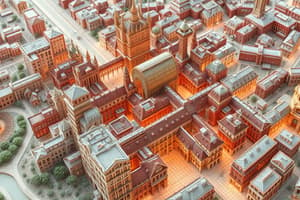Podcast
Questions and Answers
What does 'Annexation' refer to?
What does 'Annexation' refer to?
- A process of change in housing use
- A model of urban structure
- Legally adding land area to a city in the United States (correct)
- A cooperative agency for local governments
What is a Census Tract?
What is a Census Tract?
An area delineated by the U.S. Bureau of the Census for statistical publication.
What is the Concentric Zone Model?
What is the Concentric Zone Model?
A model of the internal structure of cities where social groups are arranged in a series of rings.
What is the Council of Government?
What is the Council of Government?
What is the definition of Density Gradient?
What is the definition of Density Gradient?
What is an Edge City?
What is an Edge City?
What does Filtering refer to?
What does Filtering refer to?
What is Gentrification?
What is Gentrification?
What is a Greenbelt?
What is a Greenbelt?
Define Metropolitan Statistical Area (MSA).
Define Metropolitan Statistical Area (MSA).
What is a Micropolitan Statistical Area?
What is a Micropolitan Statistical Area?
Explain the Multiple Nuclei Model.
Explain the Multiple Nuclei Model.
What is the Peripheral Model?
What is the Peripheral Model?
What is Public Housing?
What is Public Housing?
What is Redlining?
What is Redlining?
Define Rush (or Peak) Hour.
Define Rush (or Peak) Hour.
What is the Sector Model?
What is the Sector Model?
What is Smart Growth?
What is Smart Growth?
What is Sprawl?
What is Sprawl?
Define Squatter Settlement.
Define Squatter Settlement.
What does Underclass refer to?
What does Underclass refer to?
What is Urbanization?
What is Urbanization?
What is Urban Renewal?
What is Urban Renewal?
What is a Zoning Ordinance?
What is a Zoning Ordinance?
Flashcards are hidden until you start studying
Study Notes
Annexation
- Legally adds land to a city in the U.S.
Census Tract
- Defined area by the U.S. Census Bureau for statistical publication, roughly corresponds to neighborhoods in urban areas.
Concentric Zone Model
- Describes urban structure with social groups arranged in concentric rings around a central point.
Council of Government
- A cooperative agency with representatives from local governments in metropolitan areas of the U.S.
Density Gradient
- Represents the variation of population density from the urban center to its outskirts.
Edge City
- A significant area of office and retail activity located at the outskirts of a city.
Filtering
- Process of transitioning a house use from single-family ownership to potential abandonment.
Gentrification
- Transition of an urban neighborhood from low-income rentals to higher-income owner-occupied residences.
Greenbelt
- A designated area of parks or open spaces surrounding urban areas to control urban sprawl.
Metropolitan Statistical Area (MSA)
- Defined by a central city with a minimum of 50,000 residents and includes surrounding counties with economic ties.
Micropolitan Statistical Area
- Urbanized area with a population between 10,000 and 50,000, alongside its county and adjacent counties.
Multiple Nuclei Model
- Urban model proposing that cities have multiple centers or nodes of activity rather than a single nucleus.
Peripheral Model
- Depicts North American urban structure with an inner city surrounded by residential and commercial areas linked by a beltway.
Public Housing
- Government-owned housing in the U.S. rented to low-income residents, with rents set at 30% of income.
Redlining
- A discriminatory practice where banks delineate areas on maps and refuse loans for property within those boundaries.
Rush (or Peak) Hour
- The busiest traffic times, occurring in four consecutive 15-minute periods during morning and evening.
Sector Model
- Suggests urban structure with social groups arranged in sectors or wedges, expanding outward from the central business district (CBD).
Smart Growth
- Legislation aimed at controlling suburban expansion and conserving farmland.
Sprawl
- Development characterized by new housing at low density in areas not directly connected to existing urban centers.
Squatter Settlement
- Informal housing areas in developing countries where residents construct homes illegally on unowned land.
Underclass
- Social group marginalized from access to benefits and opportunities available in a developed society due to various socio-economic factors.
Urbanization
- The process that leads to an increase in both the percentage and absolute number of people living in urban areas.
Urban Renewal
- A city program targeting deteriorating neighborhoods, involving property acquisition, relocation of residents, redevelopment, and private development.
Zoning Ordinance
- Legislation that dictates allowable land use and density limits within a community.
Studying That Suits You
Use AI to generate personalized quizzes and flashcards to suit your learning preferences.



